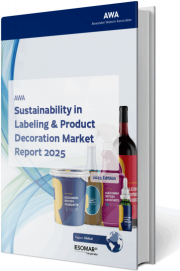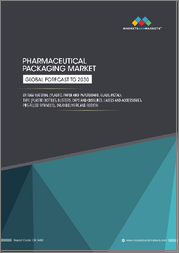
|
시장보고서
상품코드
1723663
AWA 라벨링 및 제품 장식의 지속 가능성 시장 보고서(2025년)AWA Sustainability in Labeling & Product Decoration Market Report 2025 |
||||||
이 보고서는 라벨링 업계에서 지속 가능한 개발을 둘러싼 현재의 환경을 조사하고 다양한 라벨링 기술의 기재 내역과 업계 정세를 형성하는 최근의 법규제 및 업계의 발전에 관한 귀중한 통찰력을 얻게 될 것입니다.
목차
제1장 서론
제2장 라벨 기술
- 라벨 기술
- 개요
- Pressure-sensitive Labels
- Glue-applied Labels
- Sleeve Labels
- In-mold Labels
제3장 라벨 시장의 발전과 과제
- Pressure-sensitive Labels
- 시장환경
- 제품의 용도와 최종 용도
- 라벨 재료와 지속 가능한 개발
- 재활용성
- Glue-applied Labels
- 기본적인 개요
- 라벨 기술의 위치 지정과 지속 가능한 개발
- 재활용성
- Sleeve Labels
- 기본적인 개요
- 라벨 기술의 위치 지정과 지속 가능한 개발
- 재활용성
- In-mold Labels
- 기본적인 개요
- 라벨 기술의 위치 지정과 지속 가능한 개발
- 재활용성
제4장 컨테이너 유형
- 경질 포장
- 포장 유형의 개요
- 경질 포장에 사용되는 라벨의 유형
- 연포장
- 포장 유형의 개요
- 연포장에 사용되는 라벨의 유형
제5장 매크로 동향
- 정책과 규제
- 순환형 경제와 넷 제로
- 지역 차이
- 재활용을 고려한 설계
- 소비자 동향
- 행동/라이프스타일
- 가격 민감도
- 소비자 요구
- 포장의 메가 트렌드
- 전자상거래와 디지털화/IoT
- 생분해성/바이오 베이스 포장
- 지속가능성
- 브랜드 이니셔티브
- 협회의 개요
제6장 AWA 출판물
- AWA의 연락처
Features at a glance:
- Current Sustainable Development Trends in Labeling
- Waste Generation and Recyclability by Label Technology
- Substrate Breakdown, Legislative Developments Examination
- Implications of Labeling Technologies on Sustainability
What's in it for you?
"AWA Sustainability in Labeling & Product Decoration Market Report 2025" dives into the current environment surrounding sustainable development within the labeling industry, providing a comprehensive overview. It includes a detailed discussion on waste by-products and their impact on the environment, specifically analyzing the implications of each technology used. Readers will gain valuable insights into the breakdown of substrates across various labeling technologies, along with recent legislative and industry developments shaping the landscape.
The report further elucidates the implications of labeling technologies on sustainability, addressing key environmental concerns and disposal outlooks associated with each technology. It offers an insightful overview and analysis of common packaging and labeling combinations within different end-use segments, providing a holistic perspective on the industry's sustainability efforts.
Table of Contents
1. Introduction
- 1.1. Introduction
- 1.1.1. AWA Alexander Watson Associates
- 1.1.2. Sustainability Practice
- 1.1.3. AWA Sustainability in Labeling & Product Decoration Market Report 2025
- 1.2. Methodology
- 1.3. Definitions & Abbreviations
2. Label Technologies
- 2.1. Label Technologies
- 2.2. Overview
- 2.2.1. Pressure-sensitive Labels
- 2.2.1.1. Label Technology & Sustainability
- 2.2.1.2. Waste Generation & Recyclability
- 2.2.2. Glue-applied Labels
- 2.2.2.1. Label Technology & Sustainability
- 2.2.2.2. Waste Generation & Recyclability
- 2.2.3. Sleeve Labels
- 2.2.3.1. Label Technology & Sustainability
- 2.2.3.2. Waste Generation & Recyclability
- 2.2.4. In-mold Labels
- 2.2.4.1. Label Technology & Sustainability
- 2.2.4.2. Waste Generation & Recyclability
- 2.2.1. Pressure-sensitive Labels
3. Label Market Developments & Challenges
- 3.1. Pressure-sensitive Labels
- 3.1.1. Market Environment
- 3.1.2. Product Application and End Uses
- 3.1.3. Label Materials & Sustainable Development
- 3.1.3.1. Waste Generation
- 3.1.3.2. Pressure-sensitive Label Materials - Facestock
- 3.1.3.3. Pressure-sensitive Label Materials - Release Liner
- 3.1.3.4. Pressure-sensitive Label Materials - Adhesives
- 3.1.4. Recyclability
- 3.2. Glue-applied Labels
- 3.2.1. Basic Overview
- 3.2.1.1. Market Environment
- 3.2.1.2. Variants and End Uses
- 3.2.2. Label Technology Positioning & Sustainable Development
- 3.2.2.1. Waste Generation
- 3.2.2.2. Facestock Substrates
- 3.2.2.3. Adhesives
- 3.2.3. Recyclability
- 3.2.1. Basic Overview
- 3.3. Sleeve Labels
- 3.3.1. Basic Overview
- 3.3.1.1. Market Environment
- 3.3.1.2. Variants and End Uses
- 3.3.2. Label Technology Positioning & Sustainable Development
- 3.3.2.1. Waste Generation
- 3.3.2.2. Facestock Substrates
- 3.3.2.3. Adhesives
- 3.3.3. Recyclability
- 3.3.1. Basic Overview
- 3.4. In-mold Labels
- 3.4.1. Basic Overview
- 3.4.1.1. Market Environment
- 3.4.1.2. Variants and End Uses
- 3.4.2. Label Technology Positioning & Sustainable Development
- 3.4.2.1. Waste Generation
- 3.4.2.2. Facestock Composition
- 3.4.2.3. Container Composition
- 3.4.3. Recyclability
- 3.4.1. Basic Overview
4. Container Types
- 4.1. Rigid Packaging
- 4.1.1. Overview of Packaging Types
- 4.1.2. Types of Labels used in Rigid Packaging
- 4.2. Flexible Packaging
- 4.2.1. Overview of Packaging Types
- 4.2.2. Types of Labels used in Flexible Packaging
5. Macro Trends
- 5.1. Policy & Regulation
- 5.1.1. Circular Economy & Net-Zero
- 5.1.2. Regional Differences
- 5.2. Design for Recycling
- 5.3. Consumer Trends
- 5.3.1. Behavior/Lifestyle
- 5.3.2. Price Sensitivity
- 5.3.3. Consumer Needs
- 5.4. Packaging Megatrends
- 5.4.1. E-commerce & Digitization/IoT
- 5.4.2. Biodegradable / Bio-Based Packaging
- 5.4.3. Sustainability
- 5.5. Brand Initiatives
- 5.6. Associations Overview
6. AWA Publications
- AWA Contact Details



















